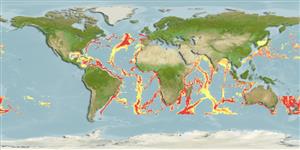Teleostei (teleosts) >
Notacanthiformes (Halosaurs and deep-sea spiny eels) >
Halosauridae (Halosaurs)
Etymology: Halosauropsis: Greek, als, alis = salt + Greek, sauros = lizard + Greek, opsis = appearance (Ref. 45335).
More on author: Günther.
Environment: milieu / climate zone / depth range / distribution range
Ecology
Marine; bathydemersal; depth range 1100 - 3300 m (Ref. 4448). Deep-water; 50°N - 47°S
Eastern Atlantic: Ireland to Mauritania and South Africa. Western Atlantic: Canada to 25°N, and off southern Brazil. Western Pacific: Australia (Ref. 7300), New Zealand and Japan (Ref. 37335). Also known from Western Indian Ocean.
Size / Weight / Age
Maturity: Lm ? range ? - ? cm
Max length : 90.0 cm TL male/unsexed; (Ref. 4448)
Dorsal spines (total): 0; Dorsal soft rays (total): 11 - 13. Body greyish-black to bluish black in color; top of head, gill isthmus and branchiostegal membranes black (Ref. 3974). Deeply pigmented sheath of lateral line. Absence of scales on the top of the head and presence of scales on the opercular bone (Ref. 37108).
Found on the lower slope, continental rise and upper abyss, primarily between 4° and 2°C isotherms. Feeds on polychaetes, crustaceans, echinoderms and echiurids. Hovers above or rests on bottom. Long slender pectorals are commonly held erect pointing upward and forward, these may serve a sensory function (Ref. 6727).
Life cycle and mating behavior
Maturities | Reproduction | Spawnings | Egg(s) | Fecundities | Larvae
Sulak, K.J., 1990. Halosauridae. p. 126-132. In J.C. Quero, J.C. Hureau, C. Karrer, A. Post and L. Saldanha (eds.) Check-list of the fishes of the eastern tropical Atlantic (CLOFETA). JNICT, Lisbon; SEI, Paris; and UNESCO, Paris. Vol. 1. (Ref. 4448)
IUCN Red List Status (Ref. 130435)
Threat to humans
Harmless
Human uses
Tools
Special reports
Download XML
Internet sources
Estimates based on models
Preferred temperature (Ref.
123201): 2.3 - 5, mean 3.3 °C (based on 1404 cells).
Phylogenetic diversity index (Ref.
82804): PD
50 = 1.0000 [Uniqueness, from 0.5 = low to 2.0 = high].
Bayesian length-weight: a=0.00087 (0.00033 - 0.00229), b=3.07 (2.84 - 3.30), in cm total length, based on LWR estimates for this (Sub)family-body shape (Ref.
93245).
Trophic level (Ref.
69278): 3.3 ±0.36 se; based on food items.
Resilience (Ref.
120179): Low, minimum population doubling time 4.5 - 14 years (Assuming tmax>10).
Fishing Vulnerability (Ref.
59153): Moderate vulnerability (41 of 100).
Nutrients (Ref.
124155): Calcium = 12.2 [3.5, 43.0] mg/100g; Iron = 0.426 [0.139, 1.080] mg/100g; Protein = 2.36 [0.00, 6.23] %; Omega3 = 0.308 [0.110, 0.875] g/100g; Selenium = 24.3 [6.7, 82.0] μg/100g; VitaminA = 5.02 [0.95, 23.69] μg/100g; Zinc = 0.317 [0.164, 0.626] mg/100g (wet weight);
